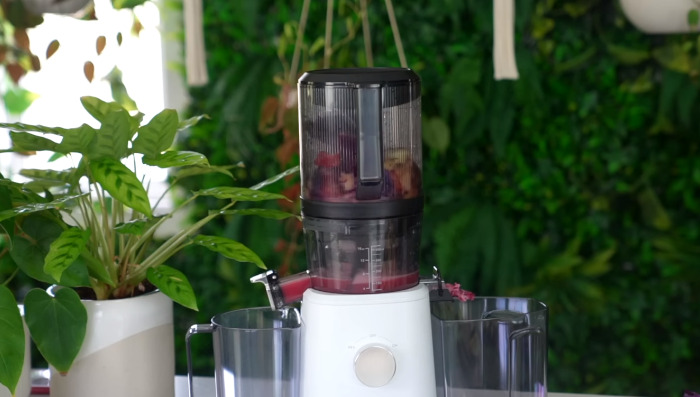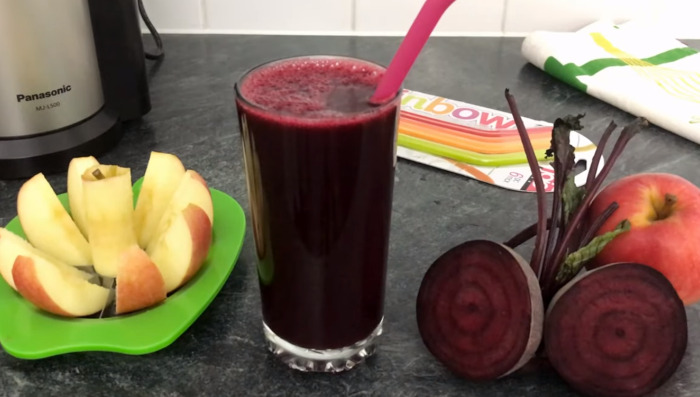Bloating is a common digestive issue that many people experience. It’s that uncomfortable feeling of fullness or swelling in the stomach area. This sensation can be caused by various factors such as overeating, consuming gas-producing foods, food intolerance, constipation, or even stress. Sometimes, bloating is just a temporary inconvenience, but chronic bloating might signal an underlying health condition.
Juicing can be a great way to alleviate bloating. Ingredients like pineapple, ginger, peppermint, and cucumber have properties that can reduce bloating and improve digestion. For instance, pineapple contains bromelain, an enzyme that helps break down proteins, while ginger is known for its soothing effects on the stomach.
Best recipes of juice for bloating:
1.Celery Juice for Bloating
Ingredients:
Making Celery Juice for Bloating is simple and effective. Here’s what you’ll need:
- Fresh Celery Stalks: About 5-6 stalks will make one glass of juice. Celery is high in water content and great for hydration, reducing bloating.
- Lemon Juice: A splash for added flavor and acidity. Lemon stimulates hydrochloric acid production, improving digestion.
- Ginger: A small piece, peeled. Ginger is known for its anti-inflammatory properties and aids in digestion.
- Cucumber: Half a cucumber. Cucumbers are high in water and act as a natural diuretic, helping with bloating.
- A Juicer or Blender: To extract the juice from the ingredients.
- Strainer: If using a blender, you’ll need this to separate the juice from the pulp.
- Ice (Optional): For a chilled, refreshing drink.
Combine these ingredients and enjoy a tasty, refreshing juice that can help alleviate bloating.
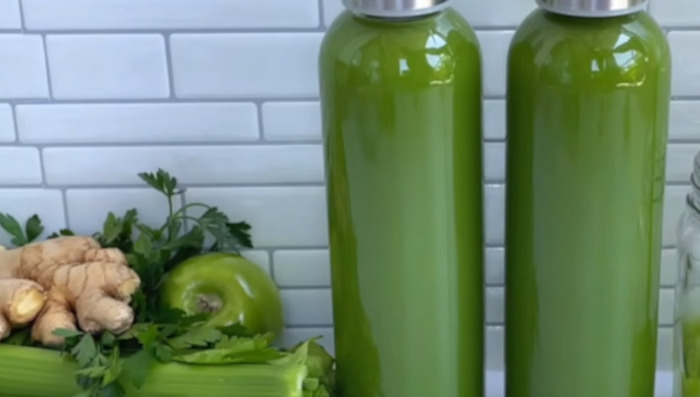
Instructions:
- Wash the Celery: Thoroughly rinse 5-6 celery stalks to remove any dirt or pesticides.
- Prepare Other Ingredients: Peel and chop a small piece of ginger, slice half a cucumber, and have a splash of lemon juice ready.
- Juice or Blend: If using a juicer, feed the celery, ginger, cucumber, and lemon juice through. If using a blender, blend these ingredients until smooth.
- Strain if Necessary: If you used a blender, strain the mixture to remove the pulp, using a strainer or cheesecloth.
- Chill (Optional): Add ice if you prefer your juice cold.
- Taste and Adjust: If needed, adjust the flavors by adding more lemon or ginger to taste.
- Serve Immediately: Pour into a glass and enjoy right away for the freshest taste.
- Store Any Leftovers: If there is any leftover, store in an airtight container in the fridge for up to 24 hours.
Enjoy your homemade Celery Juice for Bloating, knowing that the ingredients like ginger and cucumber are working to soothe your digestive system. It’s a refreshing and natural way to alleviate discomfort.
2. Aloe vera juice
Ingredients.
Making Aloe Vera juice is a simple and refreshing way to enjoy the health benefits of this unique plant. Here’s what you’ll need:
- Fresh Aloe Vera Leaf: One large leaf should suffice. Make sure it’s fresh and free of any blemishes.
- Citrus Juice: Lemon or lime juice adds a tangy flavor. You’ll need about 2 tablespoons.
- Sweetener (Optional): Honey or agave can be used to sweeten the juice if desired. Start with a teaspoon and adjust to taste.
- Cold Water: About one cup, or more if you prefer a milder flavor.
- Ice (Optional): If you like your juice chilled.
- Salt (Optional): A pinch of salt can enhance the flavors.
These ingredients combine to create a soothing and hydrating beverage. Aloe Vera is known for its anti-inflammatory properties, and adding citrus provides a vitamin C boost. Whether you’re enjoying it as a daily health tonic or using it to alleviate specific ailments, this Aloe Vera juice recipe is easy to make and pleasing to the palate.
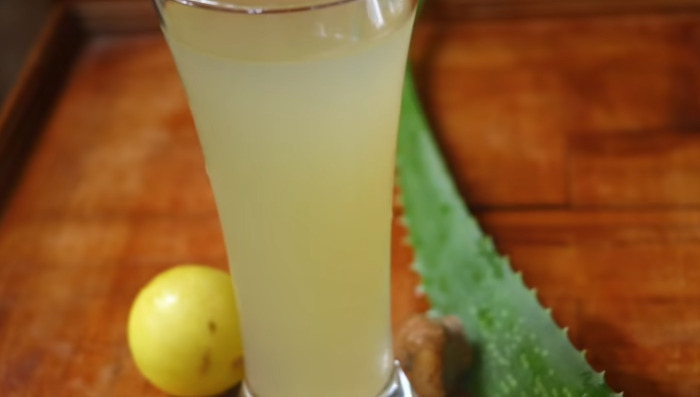
Instructions:
Making Aloe Vera juice is a straightforward process. Here are the step-by-step instructions:
- Wash the Aloe Vera Leaf: Rinse it thoroughly to remove any dirt or debris.
- Cut the Leaf: Use a sharp knife to cut off the base and the pointed tip. Slice the leaf into two halves.
- Scoop Out the Gel: With a spoon, carefully scoop out the clear Aloe Vera gel, avoiding the yellow sap near the skin.
- Blend the Gel: Place the Aloe Vera gel in a blender, add cold water, citrus juice, sweetener (if using), and a pinch of salt.
- Blend Until Smooth: Blend the mixture until it’s smooth and well combined.
- Strain the Juice: If you prefer a smoother texture, strain the juice to remove any remaining pulp.
- Chill (Optional): Add ice or refrigerate for a chilled beverage.
- Taste and Adjust: If needed, adjust the sweetness or tanginess to your liking.
- Serve and Enjoy: Pour into a glass and enjoy your homemade Aloe Vera juice.
These instructions will help you create a refreshing and healthy Aloe Vera juice. The citrus adds a pleasant tang, and the optional sweetener can balance the flavors. Enjoy this hydrating and soothing beverage as part of your daily routine or as a special treat.
3. Pineapple, grapefruit, and green tea juice
Ingredients:
Creating a juice blend with Pineapple, Grapefruit, and Green Tea is a delightful way to enjoy a refreshing and nutritious beverage. Here’s what you’ll need:
- Pineapple: 1 cup of fresh pineapple chunks. Pineapple contains bromelain, an enzyme that aids digestion.
- Grapefruit: 1 medium grapefruit, peeled and segmented. Be mindful if you’re on certain medications, as grapefruit can interact with them.
- Green Tea: 1 cup of brewed and cooled green tea. Green tea is known for its antioxidants and potential bloating reduction properties.
- Sweetener (Optional): Honey, agave, or another preferred sweetener to taste.
- Ice: A handful of ice cubes for a chilled beverage.
- Mint Leaves (Optional): A few fresh mint leaves for garnish and added flavor.
- Lemon or Lime Juice (Optional): A splash for extra tanginess.
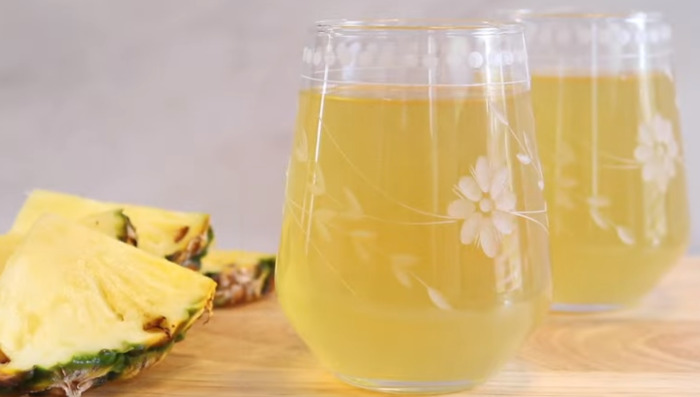
Instructions:
Pineapple, Grapefruit, and Green Tea juice is not only tasty but also packed with ingredients known to aid digestion, such as pineapple’s bromelain enzyme.
Follow these simple instructions to enjoy a refreshing, digestion-friendly beverage:
- Prepare the Ingredients: Chop the pineapple and peel the grapefruit. Brew the green tea and let it cool.
- Blend the Fruits: In a blender, combine the pineapple chunks and grapefruit segments. Blend until smooth.
- Add Green Tea: Pour in the cooled green tea to the blended fruits. Blend again to combine.
- Sweeten if Desired: Taste the juice and add sweetener if needed. Blend once more to mix.
- Add Ice: If you prefer a chilled drink, add ice and blend until the desired consistency is reached.
- Garnish: Pour the juice into glasses and garnish with mint leaves if using.
- Serve Immediately: Enjoy your homemade Pineapple, Grapefruit, and Green Tea juice right away for the best flavor.
- Store Leftovers: If you have any leftovers, store them in an airtight container in the refrigerator.
4. Carrot juice:
Ingredients:
Making carrot juice is a delightful and nutritious experience. Here’s what you’ll need:
- Carrots: 5-6 large carrots, washed and peeled. Carrots are the star ingredient, rich in fiber and essential vitamins.
- Water: 1 cup, to help blend the carrots smoothly.
- Lemon Juice: 1 tablespoon, for a tangy twist. Lemon also aids in digestion and adds a refreshing flavor.
- Ginger: A small piece, peeled. Ginger is known for its anti-inflammatory properties and adds a spicy kick.
- Sweetener: Optional, to taste. You can use honey, agave, or any sweetener of your choice.
- Ice: Optional, if you prefer your juice chilled.
- Mint Leaves: For garnish, if desired. Mint can add a refreshing touch and has been shown to help with digestion.
These ingredients come together to create a vibrant and healthful juice. Carrots are not only tasty but also provide a wealth of nutrients that can support overall well-being.
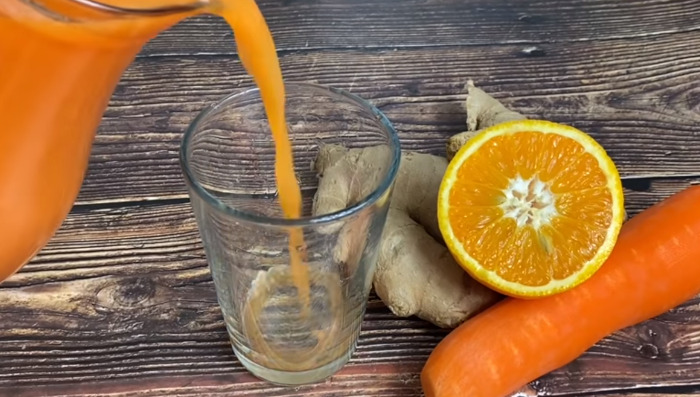
Instructions:
Follow these instructions to enjoy this refreshing juice as part of a balanced diet.
- Prepare the Carrots: Wash, peel, and chop 5-6 large carrots into manageable pieces.
- Add to Blender: Place the chopped carrots in a blender.
- Add Water: Pour in 1 cup of water to help blend the carrots smoothly.
- Add Lemon and Ginger: Include 1 tablespoon of lemon juice and a small piece of peeled ginger for flavor.
- Blend: Blend the mixture on high until smooth and well combined.
- Strain: If you prefer a smoother juice, strain the mixture through a fine-mesh strainer.
- Sweeten: Taste and add sweetener if desired. Blend again if adding sweetener.
- Serve: Pour into glasses, add ice if desired, and garnish with mint leaves.
- Enjoy: Sip and enjoy your homemade carrot juice!
The addition of lemon and ginger enhances the flavor and adds to the health benefits.
Benefits of anti-bloating juice
Anti-bloating juices offer a natural and tasty way to alleviate and prevent bloating. By choosing the right ingredients and incorporating them into a balanced diet, you can enjoy the benefits of improved digestion, hydration, and overall well-being.
1. Improved Digestion:
Anti-bloating juices often contain ingredients like ginger and pineapple, known for their digestive benefits. Ginger’s anti-inflammatory properties can soothe the stomach, while pineapple’s bromelain enzyme helps break down proteins. These ingredients work together to enhance digestion, making the process smoother and more efficient, thus reducing the uncomfortable feeling of bloating.
2. Natural Diuretic Effect:
Ingredients like cucumber and celery are high in water content, promoting hydration and acting as natural diuretics. This helps in flushing out excess water and toxins from the body, preventing and alleviating bloating caused by water retention.
3. Gentle Laxative Properties:
Certain anti-bloating juices can have a gentle laxative effect, aiding in regular bowel movements. Regularity is a sign of healthy digestion, and maintaining it can prevent constipation, a common cause of bloating.
4. Versatility and Taste:
Anti-bloating juices are not only beneficial but also delicious and versatile. You can experiment with different combinations of fruits, vegetables, herbs, and spices to create flavors you enjoy. This makes it an enjoyable way to consume essential nutrients that combat bloating.
5. Complementary to a Balanced Diet:
While anti-bloating juices can be a great addition to your diet, they should be part of a balanced and healthy lifestyle. Including whole fruits, vegetables, whole grains, and staying hydrated with water complements the effects of these juices, ensuring a comprehensive approach to digestive health.
Expert advice on juices to reduce bloating:
- Choose Fresh Ingredients: Opt for fresh fruits and vegetables that are known for their digestive benefits. Ingredients like ginger, mint, and fennel can aid in digestion and reduce bloating.
- Avoid Sugary Additives: Steer clear of adding artificial sweeteners or sugar, as they can exacerbate bloating. Stick to natural sweetness from fruits.
- Incorporate High-Fiber Foods: Include ingredients rich in fiber like apples and carrots. Fiber helps in regular bowel movements, reducing the chances of bloating.
- Limit Gas-Producing Foods: While juicing, avoid excessive use of foods that may cause gas, such as cabbage and broccoli.
- Stay Hydrated: Along with juices, ensure you’re drinking enough water. Hydration aids in digestion and can alleviate bloating.
- Use Probiotic-Rich Ingredients: Consider adding ingredients like yogurt that contain probiotics. These beneficial bacteria support a healthy gut.
- Avoid Overly Complex Mixes: Keep your juice recipes simple and easy to digest. Overly complex mixes with too many ingredients may hinder digestion.
- Consider Individual Sensitivities: Tailor your juice recipes to avoid any personal food intolerances or sensitivities that might cause bloating.
- Serve at the Right Temperature: Extremely cold juices might slow down digestion. Serve your juices at a moderate temperature.
- Chew Your Juice: Though it sounds odd, “chewing” your juice by swishing it around in your mouth can initiate the digestive process and help with absorption.
Consult a Healthcare Professional if Needed: If bloating persists, it might be wise to consult with a healthcare provider to rule out any underlying health conditions.
Wrapping up:
Bloating is a common discomfort that many face, but with the right approach, it can be alleviated. Through understanding the causes of bloating and the benefits of anti-bloating juices, we’ve explored various juice recipes tailored to ease this condition. From the simplicity of celery juice to the refreshing combination of pineapple, grapefruit, and green tea, these recipes are crafted with care, considering the nutritional balance and digestive benefits.
The instructions provided ensure an easy and enjoyable juicing experience. Along with the recipes, valuable advice on reducing bloating through mindful juicing practices has been shared. Whether you’re a seasoned juicer or just starting, these insights equip you with the knowledge to enjoy delicious, healthful juices that support your digestive well-being. Happy juicing!
FAQs
How often should I drink these juices to see an effect on bloating?
Drinking these anti-bloating juices doesn’t have a one-size-fits-all answer, as individual responses may vary. However, a general guideline is to enjoy a glass once or twice a day, preferably before meals. Consistency is key, so give it a week or two to observe any changes.
Can juicing cause bloating?
Yes, juicing can sometimes cause bloating, especially if you’re using fruits and vegetables high in certain sugars that are harder to digest. The process of juicing breaks down fiber, which can lead to a quicker release of sugars in the gut. This might cause gas and bloating in some individuals. Being mindful of the ingredients and how your body reacts can help you choose the right juices for your digestive system.
What relieves bloating fast?
To relieve bloating fast, try sipping on a warm cup of peppermint or ginger tea, both known for their digestive soothing properties. Gentle exercise like a walk can also stimulate digestion. Avoiding carbonated drinks and chewing food thoroughly can prevent excess air in the digestive tract. If you’re looking for a quick solution, over-the-counter antacids or digestive enzymes may help.




